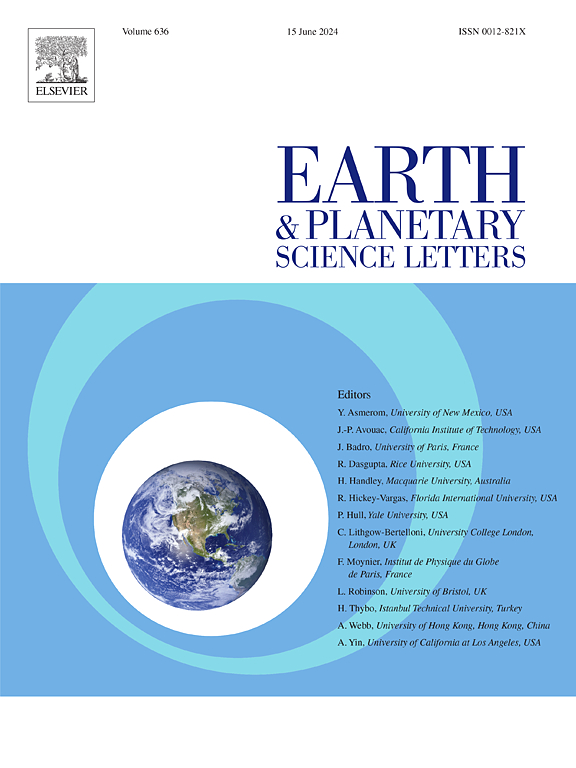Garnet clinopyroxenite formation via amphibole-dehydration in continental arcs: Evidence from Fe isotopes
IF 4.8
1区 地球科学
Q1 GEOCHEMISTRY & GEOPHYSICS
引用次数: 0
Abstract
Lower-crustal garnet clinopyroxenite (sometimes termed “arclogite”) fractionation in thick-crustal (>35 km) arc settings presents a compelling model to explain Fe-depletion trends, high oxygen fugacity, and evidence of recent delamination observed in many continental arcs. However, the origin of the garnet clinopyroxenites via igneous or metamorphic processes remains unclear. Due to the preferential incorporation of light Fe isotopes in garnet relative to clinopyroxene or amphibole, Fe isotopes are ideally suited for studying the effects of garnet fractionation on magmatic systems. Here, we present whole-rock and mineral Fe isotope data from a suite of lower to mid/upper-crustal Andean xenoliths from Mercaderes, Colombia. This data is combined with petrography, major and trace element mineral and whole-rock chemistry, geothermobarometry, and thermodynamic modeling to explore the xenoliths' petrogenesis and the Northern Andes' crustal structure. Whole-rock samples display a narrow range of Fe isotope compositions (δ56Fe = –0.02 to +0.11 ‰), which do not correlate with lithology, chemistry, or pressure-temperature conditions. This result is inconsistent with previous studies predicting the existence of an isotopically light Fe reservoir in the garnet-rich lower Andean crust. Through thermodynamic modeling, we show that the lack of isotopic fractionation in the Mercaderes xenoliths is more consistent with the suite representing a prograde metamorphic sequence, in which amphibole dehydration reactions drive metamorphism of mid/upper-crustal diorite protoliths. While our data do not preclude the presence of garnet clinopyroxenite cumulates at the base of the Andean crust, or that the delamination of such cumulates played an important role in the evolution of the Andes, they do indicate that not all garnet clinopyroxenites are cumulate in origin. Instead, the lower Andean crust represents an amalgamation of igneous and metamorphic rock, with metamorphism of mid-crustal lithologies and partial melting of mafic cumulate roots acting in tandem to drive densification and delamination of the lower crust in a self-feeding mechanism.
大陆弧中通过闪石脱水形成的石榴石霞石:铁同位素提供的证据
厚壳(35 千米)弧环境中的低壳石榴石倩辉石(有时称为 "霰粒岩")分馏提出了一个令人信服的模型,用以解释许多大陆弧中观察到的铁耗竭趋势、高氧富集度和近期分层的证据。然而,石榴石挛辉石是通过火成过程还是变质过程形成的,目前仍不清楚。与霞石或闪石相比,石榴石中的轻质铁同位素具有优先掺入性,因此铁同位素非常适合用于研究石榴石分馏对岩浆系统的影响。在这里,我们展示了一组来自哥伦比亚梅尔卡德雷斯的安第斯中/上/下地壳异长岩的整体岩石和矿物铁同位素数据。这些数据与岩相学、主要和痕量元素矿物及整岩化学、地温测量学和热力学建模相结合,探索了这些奇石的成岩过程和北安第斯山脉的地壳结构。整块岩石样本显示出窄范围的铁同位素组成(δ56Fe = -0.02 至 +0.11‰),这与岩性、化学或压力-温度条件无关。这一结果与以往研究预测的富含石榴石的安第斯山下地壳中存在同位素轻的铁储层不一致。通过热力学建模,我们发现梅卡德雷斯异质岩中缺乏同位素分馏现象,这与该岩组代表了一个级变质序列更为吻合,在该序列中,闪石脱水反应推动了中/上地壳闪长岩原岩的变质作用。虽然我们的数据并不排除安第斯地壳底部存在石榴石鳞片辉石积块,或这类积块的分层在安第斯山脉的演化过程中发挥了重要作用,但它们确实表明并非所有石榴石鳞片辉石都源自积块。相反,安第斯山地壳下部是火成岩和变质岩的混合体,中间地壳岩性的变质和黑云母积块根部的部分熔融共同作用,以一种自馈机制推动了地壳下部的致密化和分层。
本文章由计算机程序翻译,如有差异,请以英文原文为准。
求助全文
约1分钟内获得全文
求助全文
来源期刊

Earth and Planetary Science Letters
地学-地球化学与地球物理
CiteScore
10.30
自引率
5.70%
发文量
475
审稿时长
2.8 months
期刊介绍:
Earth and Planetary Science Letters (EPSL) is a leading journal for researchers across the entire Earth and planetary sciences community. It publishes concise, exciting, high-impact articles ("Letters") of broad interest. Its focus is on physical and chemical processes, the evolution and general properties of the Earth and planets - from their deep interiors to their atmospheres. EPSL also includes a Frontiers section, featuring invited high-profile synthesis articles by leading experts on timely topics to bring cutting-edge research to the wider community.
 求助内容:
求助内容: 应助结果提醒方式:
应助结果提醒方式:


